Focus on Rosette Bud Mite
go.ncsu.edu/readext?297860
en Español / em Português
El inglés es el idioma de control de esta página. En la medida en que haya algún conflicto entre la traducción al inglés y la traducción, el inglés prevalece.
Al hacer clic en el enlace de traducción se activa un servicio de traducción gratuito para convertir la página al español. Al igual que con cualquier traducción por Internet, la conversión no es sensible al contexto y puede que no traduzca el texto en su significado original. NC State Extension no garantiza la exactitud del texto traducido. Por favor, tenga en cuenta que algunas aplicaciones y/o servicios pueden no funcionar como se espera cuando se traducen.
Português
Inglês é o idioma de controle desta página. Na medida que haja algum conflito entre o texto original em Inglês e a tradução, o Inglês prevalece.
Ao clicar no link de tradução, um serviço gratuito de tradução será ativado para converter a página para o Português. Como em qualquer tradução pela internet, a conversão não é sensivel ao contexto e pode não ocorrer a tradução para o significado orginal. O serviço de Extensão da Carolina do Norte (NC State Extension) não garante a exatidão do texto traduzido. Por favor, observe que algumas funções ou serviços podem não funcionar como esperado após a tradução.
English
English is the controlling language of this page. To the extent there is any conflict between the English text and the translation, English controls.
Clicking on the translation link activates a free translation service to convert the page to Spanish. As with any Internet translation, the conversion is not context-sensitive and may not translate the text to its original meaning. NC State Extension does not guarantee the accuracy of the translated text. Please note that some applications and/or services may not function as expected when translated.
Collapse ▲Cultural Controls
Rosette bud mites are a difficult pest to control because they live inside the Fraser fir bud. However, the time frame for treating this pest provides an opportunity for controlling all Fraser fir pests except for Cinara aphids in harvested trees.
Site Selection and Rosette Bud Mite
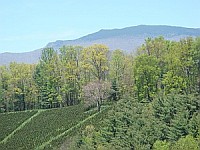 Is your farm above 3,500 feet in elevation? Is it in Avery County, NC? Is there a farm within a few miles of yours that has rosette buds? If you answered yes to any of these questions, then you are in an area where RBM are more common. Why are these factors important? The RBM requires moist conditions as it moves from the old bud into the newly developing bud. It cannot fly or move far. That’s why high elevation farms tend to have RBM, and it doesn’t spread very far or fast.
Is your farm above 3,500 feet in elevation? Is it in Avery County, NC? Is there a farm within a few miles of yours that has rosette buds? If you answered yes to any of these questions, then you are in an area where RBM are more common. Why are these factors important? The RBM requires moist conditions as it moves from the old bud into the newly developing bud. It cannot fly or move far. That’s why high elevation farms tend to have RBM, and it doesn’t spread very far or fast.
Don’t Interplant
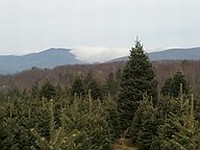 The earlier in the rotation that rosette bud mites infest a tree, the more they will affect tree growth. Interplanting allows the rosette bud mites from older heavily infested trees to infest young trees as much as 2-3 years sooner than they would if young trees were planted in a separate block. Therefore, if rosette buds are present in a field, harvest the entire block before replanting.
The earlier in the rotation that rosette bud mites infest a tree, the more they will affect tree growth. Interplanting allows the rosette bud mites from older heavily infested trees to infest young trees as much as 2-3 years sooner than they would if young trees were planted in a separate block. Therefore, if rosette buds are present in a field, harvest the entire block before replanting.
Maintain Good Fertility
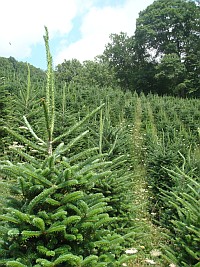 Trees grown on good soil with good, balanced nutrition don’t exhibit the effects of the rosette buds as badly because they are producing more buds to mask the damaged ones. Regular soil sampling is essential for determining the best fertilizer mix for fields with rosette buds. Taking plant tissue samples will help target key nutrients such as phosphorus that support bud formation.
Trees grown on good soil with good, balanced nutrition don’t exhibit the effects of the rosette buds as badly because they are producing more buds to mask the damaged ones. Regular soil sampling is essential for determining the best fertilizer mix for fields with rosette buds. Taking plant tissue samples will help target key nutrients such as phosphorus that support bud formation.
Shearing Practices
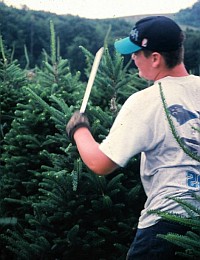 Shearing early in the summer encourages bud development, thereby improving tree density and appearance even if rosette buds are present. Many growers have tried to shear heavily to remove rosette buds. However, lighter than normal shearing leaves more healthy buds and produces better tree quality. For more information on shearing see Shaping Fraser Fir Christmas Trees.
Shearing early in the summer encourages bud development, thereby improving tree density and appearance even if rosette buds are present. Many growers have tried to shear heavily to remove rosette buds. However, lighter than normal shearing leaves more healthy buds and produces better tree quality. For more information on shearing see Shaping Fraser Fir Christmas Trees.
Early harvest or culling
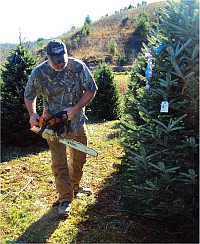 Trees heavily infested with rosette buds should be harvested. Nothing is gained by leaving these trees to grow year after year. The quality of infested trees is hard to improve, even with good chemical control and proper nutrition. Heavily infested trees will also act as a source for reinfestation after chemical control, since no material kills 100% of the mites. Some growers have avoided chemical controls entirely by harvesting these problem trees the year they are observed, even if the trees are small and thereby never allowing the population to build up.
Trees heavily infested with rosette buds should be harvested. Nothing is gained by leaving these trees to grow year after year. The quality of infested trees is hard to improve, even with good chemical control and proper nutrition. Heavily infested trees will also act as a source for reinfestation after chemical control, since no material kills 100% of the mites. Some growers have avoided chemical controls entirely by harvesting these problem trees the year they are observed, even if the trees are small and thereby never allowing the population to build up.
When Chemical Control Is Necessary
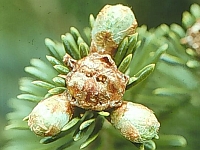 Rosette buds do not break, and therefore they affect how the tree will grow. This uneven growth creates gaps, flat sides, weak bottoms, and uneven and/or light density. But controlling the RBM won’t affect tree growth until the following growing season. Therefore, RBM control is more important in younger trees. There is no need to treat trees that will all be harvested in the current year.
Rosette buds do not break, and therefore they affect how the tree will grow. This uneven growth creates gaps, flat sides, weak bottoms, and uneven and/or light density. But controlling the RBM won’t affect tree growth until the following growing season. Therefore, RBM control is more important in younger trees. There is no need to treat trees that will all be harvested in the current year.
The incidence of RBM also does not necessarily increase each year. During dry springs, incidence actually decreases since the environment is not conducive to the mites surviving as they move from the old buds to the developing shoots. So, do not assume that RBM incidence will increase if you do nothing. Only you can determine a treatment threshold that is right for you. However, an incidence of at least 10% of the trees having RBM is recommended as a treatment threshold in 3 to 4 foot trees.
Chemical Control of RBM
Chemical control of RBM requires a systemic material that will penetrate into the developing bud and kill the mite which inhabits it. Two insecticides have provided good control of RBM – Dimethoate and Movento. Dimethoate during shoot elongation would be a good choice if you don’t need BTA control for the current year (it will provide BTA control for the following year) or if you need EHS control too. Applying Movento in Fall has been found to be somewhat effective for the following year’s RBM control according to a small 2023 trial, but Movento in April prior to bud break is a probably a better choice if you do need BTA control that year. A third chemical (Mavrik, ai: Tau-fluvalinate, a type of pyrethroid) has shown some success during shoot elongation for the current year.Magister (ai: Fenazaquin) is registered for RBM but at least one study did not find success with control.
Good control depends on good coverage. But even after a successful treatment, there still may be deformed buds produced. That is because these materials kill the mites after they have already started to feed and affect how the developing bud will grow. However, if the treatment is successful, live mites will not be present in these buds, and there will be a healthy shoot that will grow the following season. It is only the bud scales surrounding the shoot that are distorted. To learn if treatments were successful, cut open any distorted buds and examine them with a magnifying lens or under a microscope to determine if mites are present.
Re-treatment the following year may not be necessary if control was adequate, or if trees are nearing harvest. Consult your county Cooperative Extension Agent to determine if trees need to be retreated. Typically only a single pesticide application is required in a rotation to give adequate control.
Dimethoate or Mavrik During Shoot Elongation
| Pests Controlled | Treatment Description | |
|---|---|---|
| RBM BTA (for next year) SSM (not eggs) HRM (not eggs) EHS (partial control)
|
DIMETHOATE ALONE: Treat with Dimethoate when all the trees have broken bud and the new growth is out 4 to 6 inches long. A high pressure sprayer application works best. Mistblower applications may work if coverage is good enough. When Dimethoate is applied in June, the BTA is killed before it has a chance to reproduce and lay eggs for next spring. Dimethoate also provides a knock-down of SSM and HRM. Dimethoate by itself will reduce some EHS and may keep it from spreading. | |
| RBM BWA BTA (for next year) SSM HRM (not eggs) EHS (partial control)
|
DIMETHOATE + SNIPER (or other bifenthrin product): If BWA control is also required, Dimethoate by itself will not control both pests. Adding a bifenthrin product such as Sniper, Talstar or Wisdom will provide good control of BWA while also providing good SSM control. However, it may also make HRM worse the following spring, so be sure to keep scouting for mites. Use caution with this mix if EHS is a problem in the field as it will negatively impact parasitic wasps. | |
| RBM EHS BWA BTA (for next year) SSM (not eggs) HRM (not eggs) |
DIMETHOATE + ASANA: Adding Asana to Dimethoate during shoot elongation will give good control of both BWA and EHS. But as there is also a negative impact on the parasitic wasp that helps control EHS, control may not be long lasting. This combination may make HRM worse the following spring, so be sure to keep scouting for mites. Both the Dimethoate and Asana will control BTA for the following spring. | |
| RBM EHS BWA BTA (for next year) SSM (not eggs) HRM (not eggs) |
DIMETHOATE + SAFARI: Adding Safari to Dimethoate during shoot elongation will provide good control of both BWA and EHS without causing either SSM or HRM to become more of a problem. Safari control of BWA will take several weeks and EHS control may take several months. Dimethoate also provides a knock-down of SSM and HRM. When Dimethoate is applied in June, the BTA is killed before it has a chance to reproduce and lay the egg for next spring. | |
| RBM BWA BTA (SOME control this year) SSM |
MAVRIK: Mavrik has been shown to have some success in controlling RBM when applied early June. Mavrik is a type of pyrethroid and thus likely has some controlling effects upon BWA, BTA, and SSM. |
Movento Before Bud Break
| Pests Controlled | Treatment Description | |
|---|---|---|
| RBM BWA BTA (fair control this year) |
MOVENTO: Movento is an excellent systemic but it takes a while for it to work. Therefore, treat with Movento in mid-April. Mistblower applications appear to work well with this product. Control of BWA is good with this application, but control of BTA will only be fair for this spring. There will probably be some needle curl, though not enough to cause economic damage. There will not be BTA control for the following year. | |
| RBM BWA BTA (good control this year) SSM (not eggs) HRM (not eggs
|
MOVENTO + DIMETHOATE: If control of BTA is important, consider adding another product such as Dimethoate. There will probably be some needle curl, though not enough to cause economic damage. There will not be BTA control for the following year. The Dimethoate will also give a knock-down of SSM and HRM. | |
| RBM BWA BTA (good control this year) SSM
|
MOVENTO + SNIPER: Another choice of materials to add to Movento would be Sniper. Sniper will provide good control of BTA and SSM as well as giving additional control of BWA. There will not be BTA control for the following year. |


